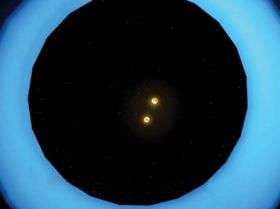Catching planets in the making

For many years, astronomers have had a clear, though ever-evolving, picture of how planets are born. It starts with a disk of dust swirling around a newborn star, and then gradually the dust particles stick together to form ever-larger pieces--grains, pebbles, boulders, protoplanets and ultimately planets.
Though the theory was clear, the only parts that could actually be observed in the real cosmos were the very beginning and end--disks of dust that have yet to form planets, and fully formed planets. Many examples of both have been found over the last decade or two. But until now, nobody had been able to detect any of the intermediates.
That changed this March, when a team of astronomers including MIT's Joshua Winn reported the first observations of a disk of this mid-sized material around a star--a swarm of stuff that has already progressed from dust grains up to particles the size of a grain of sand.
Oddball stars
But it took a real oddball of a star--or rather, pair of stars--to provide the exceptional conditions that made this detection possible.
Dust-sized material can be detected around distant stars because it gets warmed up by the star's light and emits infrared light, also known as thermal radiation, that can be detected by telescopes. Large planets, on the other hand, have enough gravitational pull to produce wobbles in the motions of the stars they orbit, and these wobbles can be detected by measuring the doppler shifts in a star's spectrum caused by its back-and-forth motion--the same principle used by a police radar gun to measure a car's speed.
But there's no such indicator for the in-between matter. "When it comes to sand or boulders, they don't emit light directly, and they don't produce wobbles," explains Winn, assistant professor of physics in MIT's Kavli Institute for Space Science and Astrophysics. "So these in-between stages are still just theoretical."
The team's new findings may have changed all that. The discovery of clear signs of sand-sized grains came as a complete surprise to the researchers, Winn says, as they studied a star called KH 15D, whose behavior had seemed just downright weird.
Longer, darker dimming
Like an ordinary variable star of a type called eclipsing binaries, it seemed to go through regular, periodic dimming, but these dark spells lasted for much longer and were much darker than could be explained by one star blocking another. The star's odd behavior was first documented in 1995 by William Herbst, an astronomer at Wesleyan University, and his graduate student Kristin Kearns. Later, observers noticed that the dark periods were getting longer and longer, and soon astronomers figured out that the dimming seemed to be caused by an unusually oriented disk of material surrounding a pair of stars.
Like a windowshade drawn to block the light, the disk was blocking the view of the stars. But as they circled each other on long elliptical orbits, one of the stars would periodically get far enough to the side to peek out from behind the shade, allowing its light to be seen. And the angle was slowly changing, obscuring the star for longer and longer periods.
Another surprise, seen from Chile
That solved the mystery of this oddball star's on-and-off appearance, but the star had another surprise in store. Using the powerful Magellan telescope in Chile, a joint venture in which MIT is a partner, they noticed that when the star went dark it didn't disappear completely: There was still a bit of light there.
Analysis of the spectrum showed a revealing clue: Like most stars, light, as seen from Earth, was shifted toward the red end of the spectrum, showing that it was moving away from us. During the dark spells, the opposite happened--the light shifted toward the blue, indicating it was coming toward us, at exactly the same speed it had been retreating.
The team soon figured out what this enigmatic shift meant. While the starlight was blocked by one part of the disk, the other side of the disk--the part farther away from us--was catching the star's rays and reflecting them back toward us, like a huge mirror. As the star sped away from us, its mirror reflection appeared to be coming toward us.
The light was not reddened, as it would be by dust particles, so the team calculated that in order to reflect the star's light in this way, without changing its color, the disk had to be made of particles that are about 1 millimeter across--the size of a typical grain of sand.
"We don't know for sure" if the grains will indeed go on to form planets in this particular oddball stellar system, Winn says. "But it seems reasonable that the material is representative of the material that could have existed around our sun" as the planets began to form. And eventually, Winn says, "we ought to be able to tell what it's made of."
Source: MIT





















